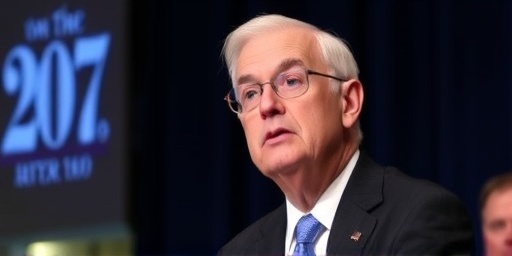In a pivotal moment for the U.S. economy, Federal Reserve Chair Jerome Powell delivered testimony before Congress that has ignited hopes for a rate cut as early as the December meeting. Speaking on the latest economic developments, Powell suggested a potential 25-basis-point reduction in interest rates, signaling a shift toward a more accommodative monetary policy amid cooling inflation and steady growth. This hint has already rippled through financial markets, with major stock indices climbing in response to the prospect of lower borrowing costs.
Powell’s remarks came during his semiannual testimony on monetary policy before the House Financial Services Committee, where he emphasized the Fed’s data-dependent approach. ‘We are well positioned to respond to evolving economic conditions,’ Powell stated, underscoring the central bank’s readiness to ease if inflation continues to moderate. This comes at a time when the benchmark federal funds rate stands at 5.25% to 5.50%, unchanged since July 2023, after a series of aggressive hikes to combat post-pandemic inflation.
Powell’s Testimony Unveils Nuanced Fed Outlook
Jerome Powell’s appearance on Capitol Hill was more than routine oversight; it was a window into the Federal Reserve‘s strategic thinking. In his prepared remarks, Powell detailed how recent economic data—ranging from softer-than-expected jobs reports to declining consumer spending—has prompted the Fed to consider dialing back its restrictive stance on interest rates. He specifically noted that core PCE inflation, the Fed’s preferred gauge, has eased to 2.7% in September from a peak of 7% in mid-2022, inching closer to the 2% target.
During the question-and-answer session, Powell fielded queries on the timing of any potential rate cut. ‘If incoming data supports it, we could see a modest adjustment in December,’ he said, avoiding firm commitments but clearly tilting toward action. This language marks a departure from the hawkish tone of earlier testimonies, where Powell had warned of prolonged higher rates. Economists interpret this as the Fed acknowledging that the battle against inflation is largely won, allowing room for supporting employment without reigniting price pressures.
To illustrate the Fed’s cautious optimism, Powell referenced key indicators: unemployment remains low at 4.1%, but hiring has slowed, with nonfarm payrolls adding only 254,000 jobs in September—below expectations. Retail sales dipped 0.1% in the same month, hinting at consumer fatigue from elevated interest rates. These trends, Powell argued, justify a ‘soft landing’ scenario where growth persists without a recession, potentially paving the way for the anticipated rate cut.
Markets Rally on Rate Cut Speculation
Wall Street wasted no time reacting to Jerome Powell’s dovish signals. The S&P 500 surged 1.2% immediately following the testimony, while the Dow Jones Industrial Average gained over 400 points. Bond yields dipped, with the 10-year Treasury note falling to 4.15%, reflecting bets on lower interest rates ahead. Investors, buoyed by the prospect of a 25-basis-point rate cut, piled into rate-sensitive sectors like real estate and utilities, which often benefit from cheaper borrowing.
Analysts from major firms echoed the enthusiasm. ‘Powell’s comments confirm the Fed is pivoting, which could unlock pent-up demand in housing and autos,’ said Greg McBride, chief financial analyst at Bankrate. Mortgage rates, hovering around 6.8% for a 30-year fixed, could drop further if the federal funds rate eases, making home loans more affordable. Similarly, credit card rates, which track the prime rate influenced by Fed actions, stand at an average of 21.5%—a potential relief for indebted households.
However, not all reactions were uniformly positive. The U.S. dollar weakened against major currencies, sliding 0.8% versus the euro, as lower rates typically erode a currency’s appeal. Cryptocurrency markets also perked up, with Bitcoin climbing above $68,000, as traders anticipate easier liquidity fostering risk assets. This market response underscores the high stakes of Federal Reserve decisions, where even subtle hints from Jerome Powell can sway billions in investments.
Economic Data Bolsters Case for Fed Rate Adjustment
Behind Jerome Powell’s testimony lies a robust set of economic data that strengthens the rationale for a December rate cut. The Federal Reserve’s latest Beige Book, released just days before the hearing, painted a picture of an economy expanding at a moderate pace across most regions, with inflation pressures easing in services and goods alike. Manufacturing output rose 0.3% in September, per the Institute for Supply Management, but supply chain snarls have largely dissipated, reducing cost-push inflation.
Consumer confidence, as measured by the Conference Board, ticked up to 108.7 in October, the highest since early 2022, suggesting households are less burdened by high interest rates. Wage growth, a key inflation driver, has moderated to 4.1% year-over-year, down from 5.5% peaks, alleviating fears of a wage-price spiral. Powell highlighted these metrics, noting, ‘The labor market is rebalancing without significant distress, which gives us flexibility.’
Globally, factors like China’s economic slowdown and Europe’s sluggish recovery add context to the Fed’s moves. Oil prices, at $72 per barrel for Brent crude, remain subdued, further dampening inflationary risks. In a ul> list of supporting stats:
- Core CPI inflation: 3.3% in September, versus 9.1% in June 2022.
- GDP growth: 2.8% annualized in Q3 estimates.
- Housing starts: Up 2.2% month-over-month, signaling builder optimism for lower rates.
These indicators collectively argue for the Federal Reserve to proceed with a rate cut, balancing growth with price stability.
Historical Precedents Shape Expectations for Fed Action
The Federal Reserve’s flirtation with a rate cut isn’t occurring in a vacuum; it draws from a rich history of monetary policy adjustments. Looking back, the last easing cycle began in March 2020 amid the COVID-19 crisis, when the Fed slashed rates to near-zero and unleashed quantitative easing. More recently, the aggressive hiking campaign from 2022 to 2023—totaling 525 basis points—mirrors the Volcker era of the early 1980s, when Paul Volcker hiked rates to 20% to crush double-digit inflation.
Jerome Powell, often compared to Volcker for his resolve, now navigates the unwind. In 2019, the Fed cut rates three times by 25 basis points each amid trade war uncertainties, a precedent for today’s scenario. That cycle boosted markets without sparking inflation resurgence, a lesson Powell likely heeds. ‘We’ve learned from past episodes that timely adjustments prevent deeper downturns,’ Powell remarked during testimony.
Critics, including some Republican lawmakers, pressed Powell on the risks of cutting too soon. ‘Have we truly tamed inflation, or is this premature?’ queried Rep. Patrick McHenry. Powell countered by citing the Fed’s dual mandate, emphasizing that waiting too long could harm employment. This exchange highlights the political tightrope the Fed walks, especially with the 2024 election looming.
From a broader lens, the current environment echoes the mid-1990s ‘Greenspan put,’ where Alan Greenspan eased rates preemptively to sustain expansion. If history rhymes, a December rate cut could extend the current bull market, now in its fifth year.
Broader Impacts: What a Rate Cut Means for Everyday Americans
As the Federal Reserve contemplates a rate cut under Jerome Powell’s guidance, the ripple effects will touch millions of Americans. For borrowers, relief is on the horizon: auto loans, currently averaging 7.2%, could ease, stimulating vehicle sales that have stagnated at 15.5 million units annually. Small businesses, facing prime rates of 8.5%, stand to benefit most, with easier access to capital potentially spurring hiring and investment.
Savers, however, face a trade-off. Certificates of deposit yielding 5% might see returns diminish, prompting a shift toward riskier assets. Retirees relying on fixed-income investments could feel the pinch, though Powell assured that the Fed monitors financial stability closely.
Looking ahead, the December 17-18 Federal Open Market Committee meeting looms large. Market futures now price in a 75% chance of a 25-basis-point cut, per CME FedWatch Tool. If realized, it could be the first in this cycle, setting the stage for more if data cooperates. Economists forecast two to three cuts in 2025, aiming for a neutral rate around 3%. Powell’s next speech at the Economic Club of New York in early December will likely provide further clues, keeping markets on edge.
Ultimately, this potential rate cut represents the Federal Reserve’s bet on sustained recovery. By lowering interest rates, the Fed aims to foster an environment where innovation thrives, jobs multiply, and inflation stays in check—shaping the economic narrative well into the new year.









